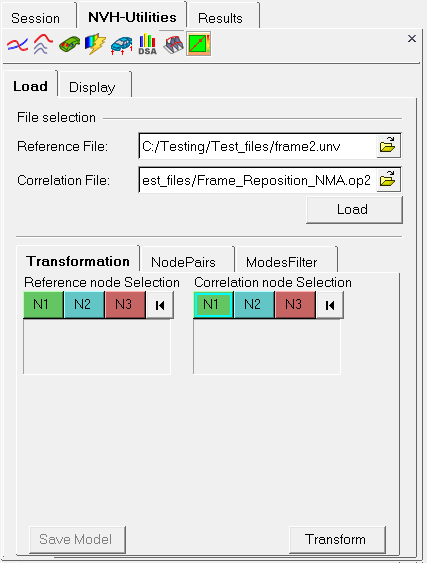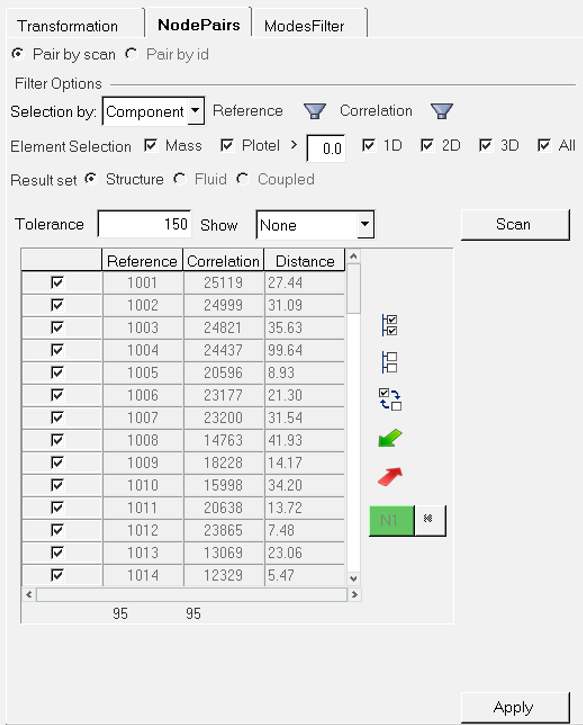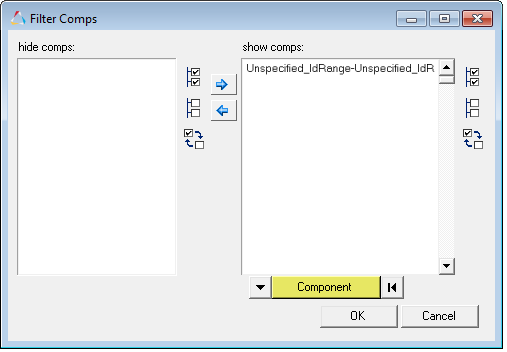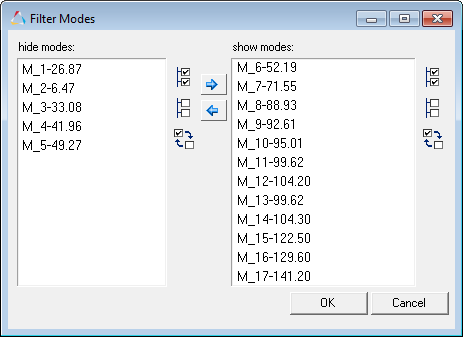MAC - Load Tab
The MAC utility's Load tab allows you to select and load the reference and correlation files and define the model files to prepare them for a MAC analysis.

The following options are available:
File selection
- H3D (*.h3d)
- OP2 (*.op2)
- UNV (*.unv)
- ODB (*.odb)
Transformation
The first step in performing a MAC analysis is to ensure that both the geometry of the finite element model and the associated results are transformed into an overplayed position in a common coordinate system.
Figure 2. Transformation Tab
- Under Reference node Selection, select three nodes from the reference model.
- Click the node selector (N1, N2, N3) to activate it, then select the node on the model in the modeling window.
- You can also double-click on a node selector to enter a node ID directly into the Select by ID dialog.
- Under Correlation node Selection, select three corresponding nodes from the correlation model, which will serve as the destination locations for the nodes selected in the step 1.
- Click Transform to correlate the two models using scaling and
positioning.
The entire reference model is transformed as a rigid body based on the transformation defined by the three nodes in step 2.
- Results associated with the reference model are transformed in the same way as in step 3.
- Click Save Model to save the transformed model.
NodePairs
The next step is to identify the node pairs between the reference and correlation models.
Figure 3. NodePairs Tab
- Pair by scan
- Identify the node pairs by scanning within the user-specified tolerance.
- Pair by ID
- Identify the node pairs with matching IDs.
- Selection by
- Submodels can be defined based on finite element (FE) components, user-defined node
sets, or a HyperWorks assembly module structure (requires a
module ID file).
From the Selection by drop-down menu, select Component, Set, or Assembly.
- Reference and Correlation Filters
- Click the filter icon,
 , for the Reference or
Correlation filters to filter components to a smaller set of
data.You can show or hide components by moving them to the appropriate column.
, for the Reference or
Correlation filters to filter components to a smaller set of
data.You can show or hide components by moving them to the appropriate column.- hide comps
- A list of components that will be hidden in the display. You can move the
components from the hide comps list to the show comps list. To do this, select
one or more components from the list and click the right arrow
 to move it to the show comps column.
to move it to the show comps column. - show comps
- The components used for the node pairs. You can move the paths in the show
comps list back to the hide comps list to reduce the list of components. You can
move the modes from the show comps list to the hide comps list to reduce the
list of components. To do this, select one or more components from the list and
click the left arrow
 to move it to the hide comps column.
to move it to the hide comps column.
- Click
 to select the entire list of
components.
to select the entire list of
components. - Click
 to deselect your current selections.
to deselect your current selections. - Click
 to exchange the currently selected components for the
unselected components in the list.
to exchange the currently selected components for the
unselected components in the list.

Figure 4. Filter Comps Dialog - Element Selection
- Select Mass and/or Plotel and enter a
length filter to identify element configurations.
You can also select 1D, 2D, and 3D elements by activating those check boxes.
- Result Set
-
- Structure
- Identify the node pairs for only structural modes.
- Fluid
- Identify the node pairs for only fluid modes.
- Coupled
- Identify the node pairs for coupled modes.
- Tolerance
- You can filter nodes in the models based on a user-specified distance tolerance. Enter a node pair tolerance value in the Tolerance field.
- Show
- Use the Show drop-down menu to display either Mapped Pair or Unmapped Nodes in the 3D modeling window. Nodes in the reference model are mapped with those in the correlation model.
- Import/Export
-
- Click Import
 to import a
.csv file containing node pairs.
to import a
.csv file containing node pairs.
OR- Click Export
 to export node pairs into a
.csv file.
to export node pairs into a
.csv file.
- Click Import
- Scan
- Click Scan to scan the model files for the filters you have defined.
- Save
- Click Save to save the node pairs you have identified.
- Apply
- Once the node pairs between the reference and correlation models are finalized, click Apply. The utility automatically goes to the ModesFilter tab.
ModesFilter

Figure 5. ModesFilter Tab
- Ref and Cor Subcase
- Use the Ref Subcase and Cor Subcase drop-down menus to select loadcases for filtering.
- Start and End Frequency
- Enter a start and end frequency range and click Select to filter the modes in that range.
- Reference and Correlation Mode List Columns
- Modes can be individually filtered using the filter icon,
 . Clicking the filter icon displays the Filter Modes dialog.
You can show or hide modes by moving them to the appropriate column.
. Clicking the filter icon displays the Filter Modes dialog.
You can show or hide modes by moving them to the appropriate column.- hide modes
- A list of modes that will be hidden from view. You can move the modes from
the hide modes list to the show modes list. To do this, select one or more
modes from the list and click the right arrow
 to move it to the show modes column.
to move it to the show modes column. - show modes
- The modes to be displayed. You can move the modes from the show modes list
to the hide modes list to reduce the list of modes. To do this, select one or
more modes from the list and click the left arrow
 to move it to the hide modes column.
to move it to the hide modes column.

Figure 6. Filter Modes DialogYou can also use the following icons to the right of the mode list columns and in the Filter Modes dialog.- Click
 to select the entire list of modes.
to select the entire list of modes. - Click
 to deselect your current selections.
to deselect your current selections. - Click
 to exchange the currently selected modes for the
unselected modes in the list.
to exchange the currently selected modes for the
unselected modes in the list.
- Animate
- To animate a mode, highlight only the mode from the list and click Animate.
- Compute Submodel MAC
- MAC
- Once the MAC calculation is complete, the utility goes to the Display tab.